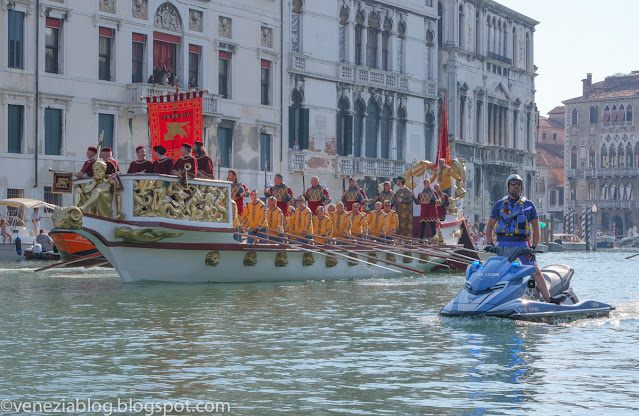
The first sight of the "Bucintoro," the first boat of the corteo, rounding into view before Ca' Foscari is always exciting. (Note the mask worn by the spectator in foreground.)










It's no problem when gondolas float alongside the corteo, as above, but it can be come rather hairy when a clueless gondolier finds himself in the wrong place at the wrong time during a race. This year a gondolier who thought he'd found the perfect spot on the San Tomà side of the Grand Canal (just about where the above image was captured) for himself and his passengers to watch the six man caorline race found himself directly in the rower's route. For the water current in the center of the Grand Canal was strong, so by the last races of the day as soon as the rowers passed Ca' Foscari they thundered toward the quieter waters on the edge of the canal--and directly toward the unfortunate gondolier and his passengers, the former of whom panicked (understandably enough) and crashed his gondola into the prow of our boat. Or would have, had I not happened to have been sitting on the nose of our boat and stopped his with my foot, while the large heavy caorline, and their large strong men, pounded past. Then he apologized and sheepishly rowed off (and I missed the chance to take any close up pictures of the caorline).
Three years ago I saw a similarly clueless gondolier and his passengers almost get run down by the leaders of the gondolini race: http://veneziablog.blogspot.com/2017/09/six-views-of-sundays-regata-storica.html (4th image from top).
Spectators watched from all manner of vantage points (above and the two images below), some of them decked out in the colors of the rowers they supported (the different colored boats are assigned to the rowers some days before the regata, allowing friends and family time enough to supply themselves with the appropriately-hued clothing and decorations).
The last place finishers of the final race had hardly rowed two strokes past the finish line when the dash for home (or bars or restaurants) was begun by those spectators who'd watched from the water.
Just to the right of the red carpeted stairs stands the mayor of Venice, waiting to present the third place finishers of the gondolini race with the green flags (made and hand-painted in Venice) they've won.
We followed our son and his voga partner as they rowed to the Giudecca to return the boat they used in their race to its cantiere there, and saw this other group of rowers completing their day on the water.
Then we headed homeward, our son stretching himself out on the front of our boat in a rare acknowledgement of fatigue--our boat his bed, and the city, it seemed, as homey and comfortable to him as his own room. It made me think I remembered a brief similar sense of things from my own childhood, though my experiences never took place on a boat, and never in Venice, but in another small town far away and bearing no resemblance to Venice--nor, now, to its former self. (photo credit: Jen)


















































